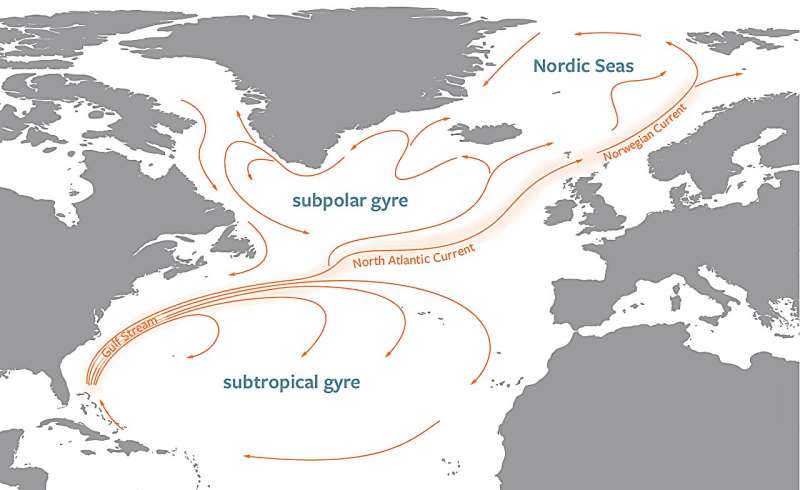This article has been reviewed according to Science X's editorial process and policies. Editors have highlighted the following attributes while ensuring the content's credibility:
fact-checked
proofread
Scientists debate Gulf Stream's role in North Atlantic currents

A new study questions the coherence of the circulation in the North Atlantic Ocean, as researchers show that the Gulf Stream exists, but variations off the coast of Florida do not necessarily reach Norway.
The real Gulf Stream flows from Florida and northward off the coast of North America. Turning east, the water crosses the Atlantic as the North Atlantic Current and continues into the Norwegian Sea as the Norwegian Current.
Traditionally this has been considered part of a continuous loop, with water flowing northward through the Atlantic Ocean and into the Nordic Seas, sinking and returning south as a deep ocean current—in total, a meridional overturning circulation.
Weaker transport in the Gulf Stream off Florida has been interpreted as a sign that climate change weakens the entire circulation in the North Atlantic. With new data, scientists question the connection between various branches of the circulation.
"You cannot measure the current in a single point and expect the data to represent the circulation of the entire North Atlantic," says Helene Asbjørnsen, an oceanographer at the Geophysical Institute at the University of Bergen, and the Bjerknes Center.
Together with colleagues from Bergen, Oxford and Southampton, Asbjørnsen has compared current data from different regions of the North Atlantic Ocean during the last decades. In a study recently published in Ocean Science, they show that the connection between variations in the real Gulf Stream and the water reaching Norway and the Nordic Seas, is small on timescales of years or decades.
While the current outside North America weakened in the decade following 2005, the inflow to the Norwegian Sea increased.
An ocean of gyres
The surface flow in the North Atlantic consists of three large gyres.
Far south, in the subtropical gyre, the water follows the Gulf Stream northward in a narrow, concentrated band. To the north of this lies the subpolar gyre. The last gyre is located within the Nordic Seas and includes the Norwegian Current, following the Norwegian coast toward the Barents Sea and Svalbard.
Water flows to the north, but also turns off to circulate within the gyres. Whether changes in the south propagate to Europe and Norway, depends on the amount of water continuing to the next gyre.

Limited long-distance connections
In the new study, the researchers have compared current measurements from various positions in the three gyres over the last decades. From the ocean outside Stad in western Norway current strength has been registered regularly since 1995, while data for the Gulf Stream outside Florida are available back to 1982.
Comparisons show that variations in the current strength in each gyre rarely propagate to the next. The reductions registered in the Gulf Stream outside North America are not seen in the middle of the Atlantic or in the Norwegian Sea.
"The atmosphere is important," says Helene Asbjørnsen.
The position and strength of the Azores high pressure system and the low pressure systems farther north vary. As the pressure steers the wind, changes in highs or lows can explain how a gyre can be strengthened without more water being carried on to the next gyre.
The Gulf Stream exists
The lacking continuity does not mean that currents in the North Atlantic are disconnected.
In a previous study Helene Asbjørnsen found that two thirds of the water outside the Norwegian coast had come from the real Gulf Stream outside Florida.
Climate models are used to simulate ocean currents through longer time periods than the observational record. Over many decades such simulations suggest that the North Atlantic behaves more like a coherent system.
Helene Asbjørnsen emphasizes that the new results concern variations in ocean currents on time scales covered by available measurements.
"Seeing signs of longterm changes in the observations is difficult with data series that are short and dominated by large regional variations from year to year and decade to decade," she says.
Climate models also agree that climate change will weaken the northern sinking, which, as well as the winds, contribute to the circulation in the Atlantic Ocean.
More information: Helene Asbjørnsen et al, Observed change and the extent of coherence in the Gulf Stream system, Ocean Science (2024). DOI: 10.5194/os-20-799-2024
Provided by Bjerknes Centre for Climate Research



















